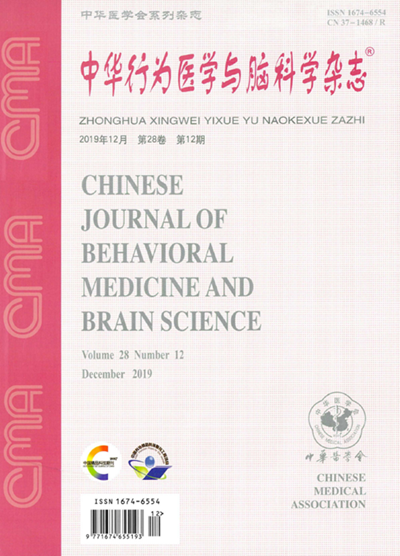Effect of Lactobacillus casei on the depressive behavior and the expression of NR1 and NR2A receptors in hippocampus of rats with postpartum depression induced by maternal separation
引用次数: 0
Abstract
Objective To investigate the effect of Lactobacillus casei on depressive behavior and the expression of NR1, NR2A receptor in postpartum depression rats induced by maternal separation. Methods Twenty-four Sprague-Dawley female rats were randomly divided into control group(CON group) (n=8), postpartum depression group(PPD group) (n=8), postpartum depression with lactobacillus casei group(PPD+ Lactobacillus casei group) (n=8). Rats of the control group were given no interventions.Rats in PPD group and PPD+ Lactobacillus casei group were given maternal separation to establish depression model.And then the rats in PPD+ Lactobacillus casei group were treated with Lactobacillus casei(8×108CFU/(kg·d)) for 4 weeks after 14 days of maternal separation.The forced swimming test (FST) was employed to detect the depressive behaviors.Lactobacillus, Bifidobacterium, Enterococcus faecalis and Escherichia coli in cecum of rats and the expression of NR1 and NR2A mRNA in hippocampus of rats were detected by real-time fluorescence quantitative PCR. Results Compared with CON group ((157.50±8.13) s), the immobility time of PPD group((200.00±10.35) s) was significantly longer (t=-3.23, P<0.05). Compared with PPD group, the immobility time of PPD+ Lactobacillus casei group ((153.25±7.41) s) was significantly shortened (t=3.67, P<0.05), and the depressive behavior was improved.Compared with CON group, the mRNA expression of Lactobacillus ((1.47±0.08), t=-5.87, P<0.01), Enterococcus faecalis ((1.23±0.08), t=-2.85, P<0.05) and Escherichia coli( (1.33±0.07), t=-4.96, P<0.01) in caecum were significantly increased in PPD group, while that of Bifidobacterium decreased significantly((0.65±0.07), t=5.18, P<0.01). Compared with PPD group, the mRNA expression of Lactobacillus( (1.05±0.05), t=3.67, P<0.01), Enterococcus faecalis ((0.97±0.05), t=2.74, P<0.05) and Escherichia coli ((1.06±0.05), t=3.31, P<0.01) were significantly decreased in PPD+ Lactobacillus casei group, while that of Bifidobacterium increased significantly ((0.98±0.04), t=-4.26, P<0.01). Compared with CON group, the mRNA expression of NR1 receptor ((0.57±0.04), t=9.65, P<0.01) and NR2A receptor ((0.60±0.05), t=8.64, P<0.05) in hippocampus of rats in PPD group were significantly decreased.Compared with PPD group, the expression of NR1 receptor ((1.01±0.05), t=-5.39, P<0.01) and NR2A receptor ((0.98±0.07), t=-3.91, P<0.05) in hippocampus were increased significantly in PPD+ Lactobacillus casei group. Conclusion Lactobacillus casei can improve the depressive behavior of postpartum depression in rats, and improve the intestinal flora, which affect the expression of NR1 and NR2A in hippocampus. Key words: Postpartum depression; Hippocampus; Intestinal flora; Lactobacillus casei; NR1 receptor; NR2A receptor; Rat干酪乳杆菌对分离产后抑郁大鼠抑郁行为及海马NR1、NR2A受体表达的影响
目的探讨干酪乳杆菌对分离产后抑郁大鼠抑郁行为及NR1、NR2A受体表达的影响。方法24只雌性Sprague-Dawley大鼠随机分为对照组(CON组)(n=8)、产后抑郁组(PPD组)(n=8)、产后抑郁合并干酪乳杆菌组(PPD+干酪乳杆菌组)(n=8)。对照组大鼠不进行干预。PPD组和PPD+干酪乳杆菌组大鼠分离母鼠建立抑郁模型。PPD+干酪乳杆菌组在母鼠分离14 d后给予干酪乳杆菌(8×108CFU/(kg·d))治疗4周。采用强迫游泳测验(FST)检测抑郁行为。采用实时荧光定量PCR检测大鼠盲肠内乳酸杆菌、双歧杆菌、粪肠球菌和大肠杆菌以及大鼠海马NR1和NR2A mRNA的表达。结果与CON组(157.50±8.13)s相比,PPD组的固定时间(200.00±10.35)s明显延长(t=-3.23, P<0.05)。与PPD组相比,PPD+干酪乳杆菌组的静止时间((153.25±7.41)s)显著缩短(t=3.67, P<0.05),抑郁行为有所改善。与CON组相比,PPD组盲肠乳酸菌((1.47±0.08),t=-5.87, P<0.01)、粪肠球菌((1.23±0.08),t=-2.85, P<0.05)、大肠杆菌((1.33±0.07),t=-4.96, P<0.01) mRNA表达量显著升高,双歧杆菌((0.65±0.07),t=5.18, P<0.01) mRNA表达量显著降低。与PPD组相比,PPD+干酪乳杆菌组乳酸菌((1.05±0.05),t=3.67, P<0.01)、粪肠球菌((0.97±0.05),t=2.74, P<0.05)、大肠杆菌((1.06±0.05),t=3.31, P<0.01) mRNA表达量显著降低,双歧杆菌((0.98±0.04),t=-4.26, P<0.01) mRNA表达量显著升高。与CON组比较,PPD组大鼠海马NR1受体mRNA表达量((0.57±0.04),t=9.65, P<0.01)和NR2A受体mRNA表达量((0.60±0.05),t=8.64, P<0.05)均显著降低。与PPD组比较,PPD+干酪乳杆菌组海马NR1受体((1.01±0.05),t=-5.39, P<0.01)和NR2A受体((0.98±0.07),t=-3.91, P<0.05)表达量显著升高。结论干酪乳杆菌可改善产后抑郁症大鼠的抑郁行为,改善肠道菌群,影响海马NR1和NR2A的表达。关键词:产后抑郁症;海马状突起;肠道菌群;干酪乳杆菌;NR1受体;NR2A受体;老鼠
本文章由计算机程序翻译,如有差异,请以英文原文为准。
求助全文
约1分钟内获得全文
求助全文
来源期刊
自引率
0.00%
发文量
8131
期刊介绍:
"Chinese Journal of Behavioral Medicine and Brain Science" (CN 37-1468/R, ISSN 1674-6554) is a national academic journal under the supervision of the National Health Commission, sponsored by the Chinese Medical Association and Jining Medical College. The journal was founded in June 1992 and was formerly known as "Chinese Journal of Behavioral Medicine" (1992-1993) and "Chinese Behavioral Medical Science" (1994-2008). In 2009, it was renamed "Chinese Journal of Behavioral Medicine and Brain Science" with the approval of the State Administration of Press, Publication, Radio, Film and Television.
The purpose of "Chinese Journal of Behavioral Medicine and Brain Science" is to implement the health and health policies of the Party and the State, implement the principle of combining theory with practice and popularization and improvement, and reflect the major progress in the theory and practical application of behavioral medicine and brain science in my country. It publishes academic papers and scientific research results in the field of behavioral medicine and brain science in my country, and has columns such as monographs/reviews, basic research, clinical research, health prevention, methods and techniques, psychological behavior and evaluation, and systematic evaluation.

 求助内容:
求助内容: 应助结果提醒方式:
应助结果提醒方式:


